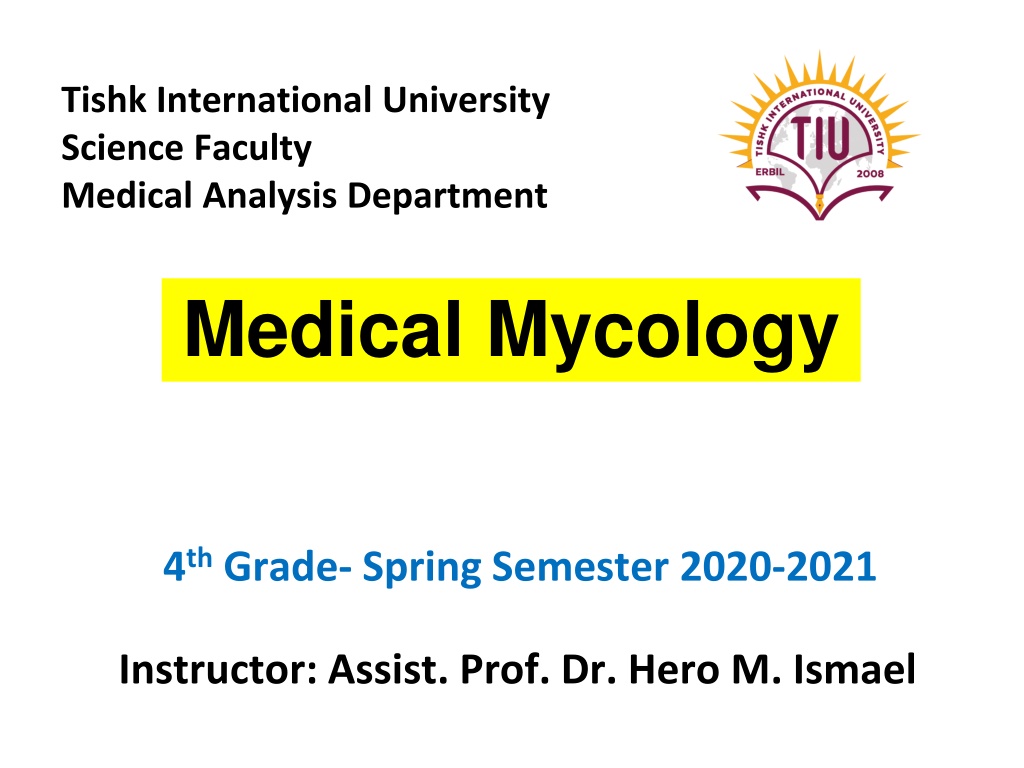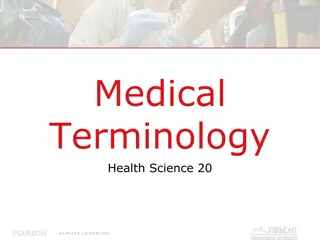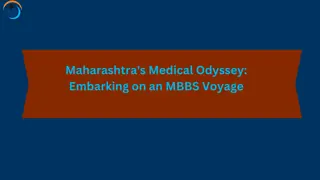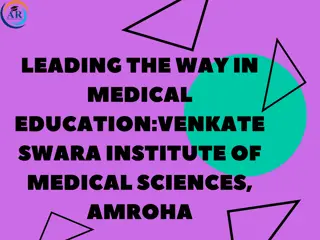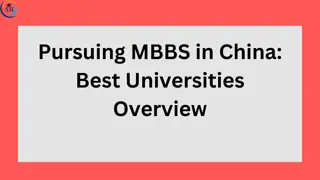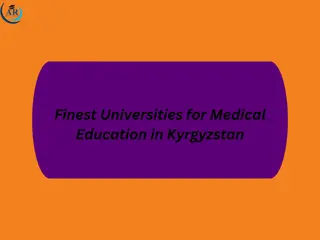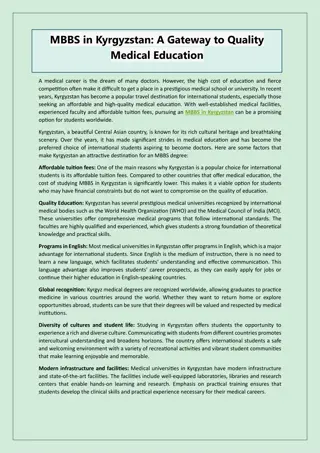Medical Mycology
The Medical Mycology course at Tishk International University delves into the realms of fungal infections, therapeutic agents, virulent factors, and classification of mycoses. Students explore various mycosis types, systemic infections, and opportunistic infections, culminating in examinations covering aspects like fungal allergies and mycotoxins. Through a mix of instructional strategies and teaching methods, students enhance their knowledge of fungi's importance, characteristics, and pathogenic potential in causing diseases in humans and animals. The course aims to develop academic reading skills and deepen understanding of medical mycology topics.
Download Presentation

Please find below an Image/Link to download the presentation.
The content on the website is provided AS IS for your information and personal use only. It may not be sold, licensed, or shared on other websites without obtaining consent from the author.If you encounter any issues during the download, it is possible that the publisher has removed the file from their server.
You are allowed to download the files provided on this website for personal or commercial use, subject to the condition that they are used lawfully. All files are the property of their respective owners.
The content on the website is provided AS IS for your information and personal use only. It may not be sold, licensed, or shared on other websites without obtaining consent from the author.
E N D
Presentation Transcript
Tishk International University Science Faculty Medical Analysis Department Medical Mycology 4th Grade- Spring Semester 2020-2021 Instructor: Assist. Prof. Dr. Hero M. Ismael
Syllabus of Medical Mycology (Theory) 2021 / 2ndSemester First week Course Introduction/ Historical Overview Fungal infections / Introduction to Medical Mycology Second week Antifungal Therapeutic Agents Third week Fungal virulent factors and Pathogenicity Fourth week The classification of Mycoses The Superficial Mycoses Fifth week Cutaneous Mycosis and Dermatophytosis
Sixth week Subcutaneous Mycoses Chromoblastomycosis Phaeohyphomycosis, Seventh week Mycetoma, Sporotrichosis Eighth week Systemic infections: Cryptococcosis Histoplasmosis Blastomycosis Coccidiodomycosis Ninth week Opportunistic infections Candidiasis
Tenth week Aspergillosis Zygomycosis Eleventh week Fungal Allergies Twelfth week Mushroom Poisonings Thirteenth week Mycotoxins Fourteenth week Examination
Course objective The course will cover Medical Mycology texts topics together with print media or internet articles which deal with currentIntroduction to fungi. Instructional strategies attempt to strikea balance between developing the students' ability to cope with Medical Mycology, extending their general academic reading skills,and increasing their basic knowledge and understanding of fungi.The course will give students a better understanding of important of fungi to human, how this field begin characteristics of fungi, systematic of fungi, Pathogenic fungi that causes disease to human and animals. ,also explain general
Forms of Teaching: Different forms of teaching will be used to reach the objectives of the course: power point presentations for the head titles and definitions and summary of conclusions systematic of fungi and any other illustrations, besides worksheet will be designed to let the chance for practicing on several aspects of the course in the classroom, furthermore students will be asked to prepare research papers on selective topics and summarise articles contents published in English into either Kurdish or Arabic language, those articles need to be from printed media or internet articles. There will be classroom discussions and the lecture will give enough background to translate, solve, analyze, and evaluate problems sets, and different issues discussed throughout the course. To get the best of the course, it is suggested that you attend classes as much as possible, read the required lectures, teacher s notes regularly as all of them are foundations for the course.
Grading: The students are required to do one closed book exam at the mid of the semester besides other assignments including translations and one research paper. The exam has 25 marks, the attendance, classroom activities; translations and research paper count 10 marks. There will be a final exam on 60 marks. So that the final grade will be based upon the following criteria: Practical Examination: Theory examination: Class Activity Quiz Attendance Report Final examination theory Medical Mycology / 60 marks
References Kauffman C.A., Pappas P. G. Sobel J. D. and Dismukes W. E. (2011). Essentials of Clinical Mycology, 2nd ed., Springer New York Reiss, E., Shadomy H. J. and Lyon G. M. (2012). Fundamental Medical Mycology. Wiley-Blackwell. Dismukes W. E., Pappas P. G. and Sobel J. D. and (2003). Clinical Mycology, 2nd ed., Springer New York Alexopouloss, C.J., Mims, C.W. and Blackwell. (1996). Introductory mycology Karen C. Carroll, Jeffery A. Hobden, Steve Miller, Stephen A. Morse, Timothy A. Mietzner, Barbara (2013). Jawetz, Melnick, & Adelberg s Medical Microbiology Twenty-Sixth Edition. Kwon-Chung K.J. and Bennett J. E. (1992). Medical Mycology . Lea and Febiger.
How medical mycology began in the dim past? Medical mycology is concerned with the study of medically important fungi and fungal diseases in humans and lower animals. Fungal infections occur throughout the world, but some of them are more predominant or endemic in certain geographic areas.
During the last 15 years, the incidence of fungal infections has increased as a result of the AIDS pandemic and the rapidly expanding number of patients with chemically induced immunosuppression, transplants, and cancer. As a result of improved management protocols, these patients are able to live longer, thereby becoming highly susceptible to life-threatening opportunistic fungal infections.
Even though the history of medical mycology involving humans began between 1837 and 1841, when Gruby and Remak discovered the first human mycosis (tinea favosa), the Italian lawyer and farmer Agostino Bassi who in 1835 discovered the mycotic nature of an epidemic disease of silkworms called muscardine. He was the first individual who demonstrated that a microorganism, a fungus, could cause an infectious disease. The recognition by the Europeans of the relationship between fungi and disease in humans was the basis for the development of medical mycology.
By the end of the 1890s, Raimond J Sabouraud had crystallized and organized the scattered observations regarding the role of pathogenic fungi in dermatophytic infections, and his work marked the transition from the study of the dermatophytoses to that of systemic mycoses in the United States during the 1890s. This transition initiated the development of medical mycology in this country.
Detection of Fungal Infections Over the course of time, more than 120,000 species of fungi have been recognized and described. However, fewer than 500 of these species have been associated with human disease, and no more than 100 are capable of causing infection in hosts that are immunocompromised.
Unlike the names of fungi, disease names are not subject to strict international control. Their usage tends to reflect local practice. One popular method has been to derive disease names from the generic names of the causal organisms: for example, candidiasis, . etc. aspergillosis,
Moreover, to ensure that the most appropriate laboratory tests are performed, it is essential for the clinician to indicate that a fungal infection is suspected and to provide sufficient background information.
In addition to specifying the source of the specimen, the clinician information on any underlying illness, recent travel or previous residence abroad, and the patient s occupation. This information will help the laboratory to expect which pathogens are most likely to be involved and permit the selection of the most procedures. should provide appropriate test
These differ from one mycotic disease to another, and depend on the site of infection as well as the presenting symptoms Interpretation of the results of laboratory investigations can sometimes be made with confidence, but at times the findings may be helpful or even misleading. and clinical signs.
Laboratory methods for the diagnosis of fungal infections remain based on three broad approaches: Detection of the etiologic agent in clinical material microscopically. Isolation and identification of the pathogen in culture The detection of a serologic response to the pathogen or some other marker of its presence, such as a fungal cell constituent or metabolic product.
Direct Microscopic Examinationof Clinical Specimens Direct microscopic detection of fungal elements in clinical material including skin scrapings and other dermatological specimens, sputum and other lower respiratory tract specimens, and minced tissue samples can be examined after treatment with warm 10% 20% potassium hydroxide (KOH). These samples can then be examined directly, without stain, as a wet preparation in a matter of minutes. This examination is very helpful to guide treatment decisions, to but is less sensitive than culture.
fungal stain can be mixed with the sample on the microscope slide. Another useful tool is the chemical brightener: Calcofluor white, a compound that stains the fungal cell wall. The preparation is stained with calcofluor white, with or without KOH, and then read with a fluorescence microscope. The fungal elements appear brightly staining against a dark background. India ink is useful for negative staining of cerebrospinal fluid (CSF) sediment to reveal encapsulated Cryptococcus neoformans cells.
Gram staining can be helpful in revealing yeasts in various fluids and secretions. Giemsa stain and Wright s stain can be used to detect Histoplasma capsulatum in bone marrow preparations or blood smears.
Histopathologic Examination Histopathologic examination of tissue sections is one of the most effective methods for diagnosis of subcutaneous and systemic fungal infections. There are a number of special stains for detecting and organisms. Periodic acid-Schiff (PAS) staining is the most widely used. highlighting fungal
Culture examination Isolation in culture will permit most pathogenic fungi to be identified. For these reasons, most laboratories use several different culture media and incubation conditions for recovery of fungal agents. However, a variety of additional incubation conditions and media may be required for growth of particular organisms in culture.
Most laboratories use a medium such as the Emmons modification of Sabouraud s dextrose agar, or potato dextrose agar that will recover most common fungi. However, many pathogenic fungi, such as yeast- phase H. capsulatum, will not grow on these substrates and require the use of richer media, such as brain heart infusion agar.
A variety of chromogenic agars that incorporate multiple chemical dyes in a solid medium can be purchased commercially for identification of Candida spp. (CHROMagar Candida medium)
Blood Culture The fungal blood culture is rarely used as the first line for diagnosing a patient with any possible fungal infection. The fungal Isolator tube is reserved for patients with suspected sepsis from the Dimorphic or other filamentous fungi that are not recovered from routine blood cultures, the Isolator fungal tubes had a higher sensitivity for detecting fungemia.
Fungal Identification Most fungi can be identified after growth in culture. Classic phenotypic identification methods for molds are based on a combination of macroscopic and microscopic morphologic characteristics. Macroscopic characteristics, such as colonial form, surface color and pigmentation, are often helpful in mold identification, but it is essential to examine slide preparations of the culture under a microscope. If well prepared, these will often give sufficient information on the form and arrangement of the conidia and the structures on which they are produced for identification of the fungus to be accomplished. Because identification is usually dependent on visualization of the spore-bearing structures.
Molds often grow best on rich media, such as Sabouraud s dextrose agar, but overproduction of mycelium often results in loss of sporulation. If a mould isolate fails to produce spores or other recognizable structures after 2 weeks, it should be sub cultured to a less-rich medium to encourage sporulation. cornmeal, oatmeal, malt, and potato-sucrose agars can be used for this purpose. Media such as
characteristics include the color of the colonies, the size and shape of the cells, the presence of a capsule around the cells, the production of hyphae or pseudohyphae, and the production of chlamydospores. Useful biochemical tests include the assimilation and fermentation of sugars and the assimilation of nitrate and urea. Most yeasts associated with human infections can be identified using one of the numerous commercial identification systems, such as the API 20C, API 32C, Vitek Yeast Biochemical Card, Vitek 2 YST (all BioMerieux), MALDTOF, that are based on the differential assimilation of various car- bon compounds.
Useful biochemical tests include the assimilation and fermentation of sugars and the assimilation of nitrate and urea. Most yeasts associated with human infections can be identified using one of the numerous commercial identification systems, such as the API 20C, API 32C, Vitek Yeast Biochemical Card, Vitek 2 YST (all BioMerieux), MALDTOF, that are based on the differential assimilation of various carbon compounds.
Molecular Methods for Identification of Fungi The last decade has seen a massive expansion of research into the phylogenetics of pathogenic fungi. Analysis of mitochondrial, and other nuclear DNA sequences has been used to determine degrees of genetic relatedness among many groups of fungi. Phylogenetics research has led to the deposition in international databases of large numbers of DNA sequences for many groups of fungi, both pathogenic and saprophytic. aligned ribosomal,
Portions of the multicopy ribosomal DNA genes are most commonly used as targets in species identification. The internal transcribed spacer (ITS) 1 and ITS2 regions have been shown to contain sufficient sequence heterogeneity to provide differences at the species level.
Serologic Tests Serologic testing often provides the most rapid means of diagnosing a fungal infection. The majority of tests are based on the detection of antibodies to specific fungal pathogens, serologic tests can be diagnostic, e.g., tests for antigenemia in cryptococcosis and histoplasmosis, and similar tests have been developed for aspergillosis and candidiasis.
Antigen detection methods are complicated by several important factors: 1 Antigen is often released in minute amounts from fungal pathogens 2 Fungal antigen is often cleared very rapidly from the circulation. 3 Antigen is often bound to circulating IgG, even in immunocompromised individuals.
Numerous methods are available for the detection of anti- bodies in persons with fungal diseases. Immunodiffusion (ID) is a simple, specific and inexpensive method, but it is insensitive Complement fixation (CF) is more sensitive, but more difficult to perform and interpret than ID. However Latex agglutination (LA) is a simple but insensitive method that can be used for detection of antibodies or antigens. More sensitive procedures, such as enzyme-linked immunosorbent assay (ELISA), have also been developed and evaluated for the diagnosis of a number of fungal diseases.
